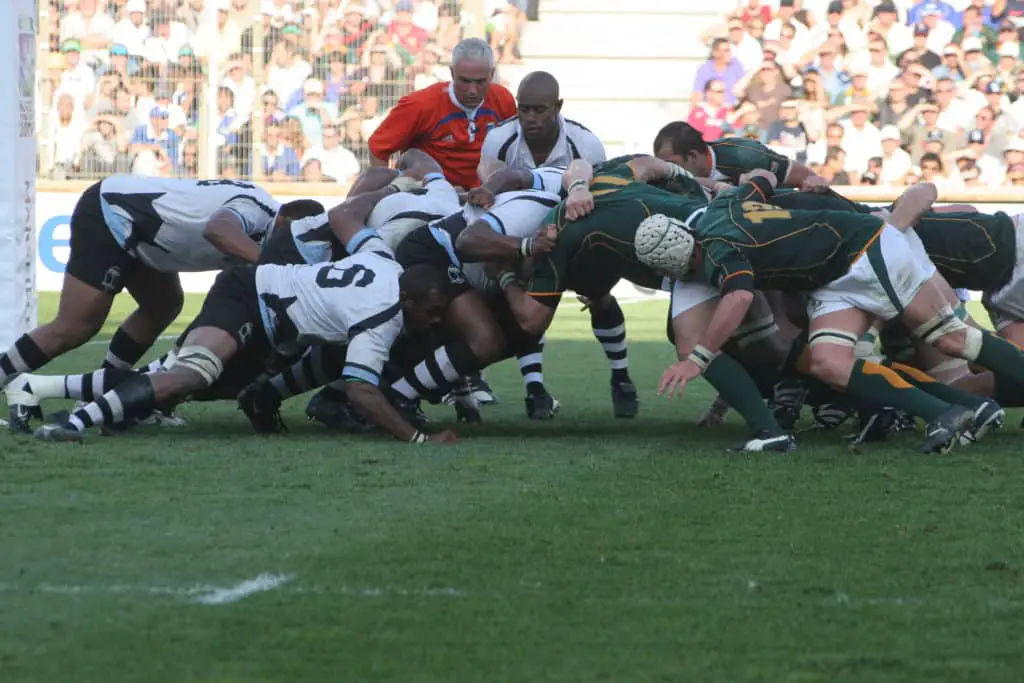It’s not all about oranges and cups of tea anymore. Half time is a serious business and must be gotten right. Whether that means a change of shirts, or a quick massage, it all has to be carefully managed to fit into the limited time available.
Rugby union consists of two halves of 40 minutes, plus injury time. There is a 10-15 minute break between halves. In the professional game it is a 15 minute break whilst in the amateur game coaches, upon agreement, can reduce this to 10 minutes. If they do not agree then the referee decides the length of half time.
The official rule from World Rugby is:
“Half-time consists of an interval not exceeding 15 minutes as decided by the match organiser. During this time, the teams and match officials may leave the playing enclosure.” – Rule 5, World Rugby
On this page, we are going to go into depth on the various Rugby Union half-time rules, as well as answer some of the more burning questions that people have when it comes to what happens during and after half time.
When Is Half Time in Rugby Union?
Although a half of rugby is 40 mins long it does not mean that half time will be taken after 40 minutes. This is because during the game the referee is constantly stopping and starting the game time depending on what is happening on the pitch. This means it often takes 50 minutes or more to play the 40 minute half.
In the past, the referee had the discretion to add a few minutes onto the length of a half, much in the same way as soccer. This means that any stoppages (e.g. for injuries) were accounted for.
Nowadays, Rugby Union doesn’t add extra minutes. Instead, it stops the clock whenever a stoppage occurs. The clock will be restarted at the end of the stoppage. Because of this, the Rugby Union time clock may say 40-minutes, but the half will last a bit longer than this. The more stoppages, the longer the half is going to be.
These days the Television Match Official is often called upon to help make certain decisions correctly. They can replay the action in slow motion multiple times until they feel ready to make a decision. This can add many minutes to a half of rugby.
At this point you might also be interested in Rugby Union: Extra Time, Overtime, and Injury Time Rules Explained (Examples).
Maximum Length of Half Time in Rugby Union?
By the rulebook, the maximum half-time length in Rugby Union is 15-minutes. This means that the players need to be back out there on the field, ready to play, within 15-minutes of the first half ending.
However, that is the maximum. Each Rugby Union competition (leagues and cups) will be responsible for setting their own maximum half-time length. Most professional Rugby Union leagues set the half-time length to around 10-12 minutes. It is unusual to find a competition that goes all the way up to the maximum of 15-minutes allowed, but international matches do!
International matches always feature a 15 minute half time break due to pressures from broadcasters and sponsors to deliver enough air time for their brands. With this being one of the major sources of finance for the game it makes sense to keep them happy.
These rules aren’t quite as set in stone for youth games and mini rugby games in which the length of the half time is really at the discretion of the referee. In my experience they will allow each team to have a chat with their coaches get themselves a drink and then give a one minute warning for the start of the second half.
With most parents generally keen to get the second half under way, a 5 minute break is generally all that is taken, and sometime less if there are multiple games to play. Don’t forget that junior matches vary greatly in length depending on the age group. Read more about age grade rules here.

What Happens During Half Time In Rugby Union?
Players and officials usually leave the field and go to the dressing rooms to prepare themselves for the second half. However, occasionally a team will stay out on the pitch to run some drills if they feel a quick fix is required.
For the players and their coaches, half-time is not just about having a break, but to discuss tactics for the second half. By this point of the game, the players and coaches will have been able to spot the weaknesses and the strengths of the opposing side.
You can see the half time team talk from the South African dressing room at the last world cup here.
Key messages related to what a team needs to do next are relayed as concisely as possible to the players who can only really take on board short messages, lengthy explanations will simply be left behind in the changing room. Sometimes it is as simple as ‘attack the blindside, use the wind, pick and go’.
Those few key phrases can then be acted on by the players without much more thought, although you will still see water carriers and substitutes running on and reminding players of these tactics
Half-time is pretty much the only opportunity that the coach will get to speak to the players directly. Because of this, you will likely notice most teams (particularly losing teams) will change up their structure by the time the second half rolls around and it is often a time for substitutions.
It has become common place for a team to replace their front row forwards at half time or just after with a completely new set of front row forwards so these guys will be vigorously warming up.
Players will also take the time to hydrate themselves, and may even consume some sort of energy drink or snack such as a banana. They won’t have long to do it, though. They need to get right back onto that field without feeling bloated!
Half time is also ideal for the physio to get to work. Massages will be given, vaseline and deep heat applied, ice may be applied and players will do individual stretches to keep themselves ready for the second half.
Captains will of course play their role and usually deliver a short team speech outlining what needs to be done in the second half, this is often done after the coaches have left the room so it can be a little more ‘direct’ than some of the coaches messages.
For the officials, half-time is a chance for them to take a break. Running around the field can be quite exhausting! They may wish to speak to either or both of the team captains if there is an issue they feel they need to sort out, but this is rare, most of the talking is done on the pitch
You might want to check out: Scrum Rules Explained (Simple Explainer)., or our guide to rugby slang and terms here.
What Happens After Half Time In Rugby Union?
The players must be back on the field by the end of the half-time period. This doesn’t mean that they start heading out onto the playing field at the end of the allotted time. They need to be lined up, ready for the game to start again.
While the game could feasibly start without the full team back on the pitch, it is unlikely. Delays can happen and the referee usually counts the number of players on the pitch before restarting the game.
The teams will of course switch sides of the field. In addition to this, the team that didn’t kick off the first half will kick off the second half. The second half of the game will also be 40-minutes, plus any stoppages.
Interestingly, a game of rugby union can actually go on much longer than 80 minutes because the game can only end through natural means when the ball goes dead. This means a team can keep playing multiple phases beyond the 80 minutes if they have the desire and ability to do so.
A famous example of this was the France versus Wales clash in the Six Nations in 2017. The game went on for an incredible 100 minutes, though fortunately this is not the norm it does happen.
You might also be interested in our article: What sports have overtime/extra time?
Image Credits
Match at Thomond Park, Limerick, between the “A” national rugby union teams of Ireland and Australia BobTheCorkDwarf’s photos, CC BY 2.0, via Wikimedia Commons
Match between South Africa and Fiji during 2007 Rugby World Cup in Marseille (France). gepiblu, CC BY-SA 2.0, via Wikimedia Commons.
